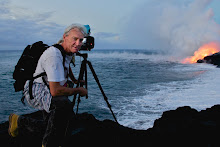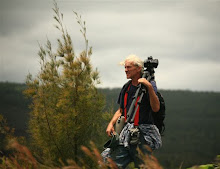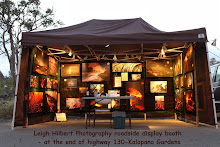 (Click on the images for a larger size)
(Click on the images for a larger size)I took this daytime view above is of the Halema’uma’u Crater a few days ago as seen from the craters rim just east of the Jaggar Museum.
Yesterday, March 19th, 2010 marked the two-year anniversary of the explosive appearance of the active lava vent. The United States Geological Survey posted this image below on their images site here,
 along with this descriptive caption of the event:
along with this descriptive caption of the event: “The ongoing summit eruption at Kīlauea began on this day two years ago. This thermal image (white is hot, dark blue is cold), taken during today's helicopter overflight, shows the current vent configuration at Halema`uma`u crater. The vent cavity is about 130 meters (430 ft) wide, and has consumed portions of the wall and floor of Halema`uma`u crater. The vent cavity resides directly below the former Halema`uma`u Overlook, which was badly damaged in the March 19, 2008, vent opening explosion. The active lava surface (about 70 meters, or 230 ft, wide) is situated at a depth of about 200 meters (660 ft) below the rim of the vent cavity. The lava surface consists of large crustal plates—clearly discernable in this image—which slowly migrate from north to south, reflecting circulation in the lava column. A small degassing hole resides on the floor of the vent cavity as well, just south of the lava surface.
Meanwhile on the Pu`u O`o eruption site, east from Kilauea’s Halema’uma’u, molten lava continues to flow through lava tubes and occasionally break out onto the surface high up on the cliffs. Views of flowing lava further down the pali and out onto the coastal flats heading toward the ocean has been rather subdued but visible at times after dark.
Presently the best views for the public of active daytime venting and nighttime lava glows remain within the Volcanoes National Park as seen from the Jaggar Museum. The Park is open 24 hours a day. Rain, fog, vog and blowing mist are often wafting through the park but with patience clear dry air also comes along and opens good viewing opportunities.
For more information:
Hawai`i Volcanoes National Park phone Visitor Information 985-6000
Lava Viewing Hotline for coastal lava information: 961-8093 (NOTE: Hawaii County has contracted out the management of the Lava Viewing Area located at the terminus of highway 130 near Kalapana, but as far as I know the hours remain the same, 5:00 PM to 10:00 PM, and the Civil Defense phone number above is still updated.)
NOTE: I will not be updating this blog daily due to little change in lava activity and a busy schedule for me these days. I will add updates if conditions radically change,
Aloha,
Leigh














